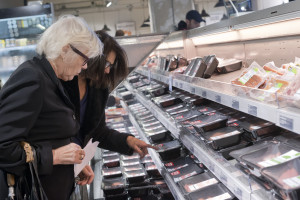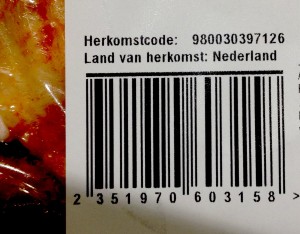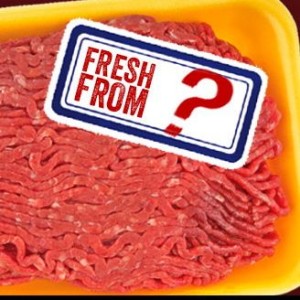New legislation: COOL for unprocessed meats
Posted: April 12, 2015 Filed under: Food | Tags: COOL, labelling, meat, origin Comments Off on New legislation: COOL for unprocessed meats In a previous post from January last year I wrote about country of origin labelling (COOL). I mentioned that the Commission was expected to adopt implementing rules on mandatory COOL for unprocessed meat of sheep, goat, pig and poultry, based on the Food Information to Consumers Regulation. A nice infographic about the new EU food labelling rules can be found here.
In a previous post from January last year I wrote about country of origin labelling (COOL). I mentioned that the Commission was expected to adopt implementing rules on mandatory COOL for unprocessed meat of sheep, goat, pig and poultry, based on the Food Information to Consumers Regulation. A nice infographic about the new EU food labelling rules can be found here.
And now there is ‘COOL’ news: rules on origin labelling for meat apply from 1 April 2015. Which rules? The Commission adopted Regulation 1337/2013 on the indication of the country of origin or place of provenance for fresh chilled and frozen meat of swine, sheep, goats and poultry.
Background and scope
As from 1 April 2015 no packaged unprocessed meat product from abovementioned animals may be lawfully placed on the market in the European Union without a label indicating where the animal was reared and slaughtered. An exception applies to meat that was lawfully placed on the Union market before 1 April 2015. This may be sold until the stocks are exhausted, provided of course that the best before date/use by is not exceeded.
The European COOL rules do not apply to processed meats. In December 2013 the European Commission published a report concerning mandatory country of origin labelling (COOL) for meat as an ingredient. The overall conclusion of the report is that consumer interest in COOL is strong, but this is not reflected in the willingness pay for the extra costs for FBOs and an additional administrative burden. Read this post if you want to recall the discussion on the December 2013 report. Click here for the response (in Dutch) from the Dutch Food Industry Federation (FNLI) on the resolution and here for an article on this topic on the website of EurActiv. Until now, COOL has not been extended to processed meats, however this may change. In this resolution from February 2015, the European Parliament urges the Commission to follow up its report with legislative proposals making the indication of the origin of meat in processed foods mandatory. It is expected that this will ensure greater transparency throughout the food chain and it will rebuild consumer confidence in the wake of the 2013 horsemeat scandal, and other food fraud cases. This seems contrary to the outcome of the report in terms of feasibility as COOL for processed meats means higher costs for the industry and an increased administrative burden.
Now let’s have a look at the new rules. What is meant with ‘country of origin’ and what information should be placed on the label? Continue reading to find out!
Labelling rules
The core provision of the new Regulation is Article 5, which lays down the COOL rules for the meats covered by the Regulation. Either the indication (i) ‘origin’, (ii) ‘reared in’ + ‘slaughtered in’, or (iii) a list of different indications should be placed on the label according to Article 5.
What is meant with ‘country of origin’ for meat products?
Recital 3 of Regulation 1337/2013 refers to the concept as set out in Articles 23 to 26 of Council Regulation 2913/92 (Customs Code). For meat products the country of origin means the country in which the animal was born, reared and slaughtered. Only in this situation the following indication may be placed on the label as far as the food business operator is able to prove the correctness of the statement to the competent authority:
- ‘Origin: (name of Member State or third country)’
But what if the meat comes from animals, which were born, reared and slaughtered in different countries? In that case in indication of the country (Member State or third country) where the animal was reared and the country where the animal was slaughtered have to be specified on the label.
‘Reared in’
Article 5 of the Regulation gives specific criteria to determine the correct indication for the country where the animal is ‘reared in’ related to the rearing period of the animal in a country. If the specified rearing period is not attained in any country the label must show one of the following indications:
- ‘Reared in: several Member States’
- ‘Reared in: several non-EU countries’
- ‘Reared in: several EU and non-EU countries’
- ‘Reared in: (list of Member States or third countries where the animal was reared)’
The last option may only be used if the FBO is able to prove this to the competent authority.
‘Slaughtered in’
The Member State or third country in which the slaughter of the animal took place has to be indicated as follows:
- ‘Slaughtered in: (name of the Member State or third country)’
If pieces of meat, of the same or different species, are packed together and correspond to different labelling indications, the label has to indicate the list of relevant countries for each species (see Article 5(3)).
Furthermore, the batch code identifying the meat supplied to the consumer or mass caterer should be placed on the label.
A little extra : COOL in the U.S.
: COOL in the U.S.
If you are a FBO operating both in the EU and the US you might be interested in COOL in the U.S. Like Europe, the U.S. COOL statute defines multiple origins for muscle cuts of meat, depending on where the animal was born, raised and slaughtered. This is pretty much in line with Europe, which defines “born, reared and slaughtered” as the origins that must be placed on the label. Do you want to learn more about COOL in the US and how the new EU rules are perceived in the U.S.? Here is an article.
The United States Department of Agriculture (USDA) Agricultural Marketing Service has published a practical COOL labelling guide for the industry with specific examples of appropriate COOL language for the U.S. market. You can find it here.
Cool with COOL?
What is the potential impact of the new rules on your business? With an increased complexity of the label this is likely to increase the costs for compliance. Consumers will receive extra information, but will they see this as an improvement? With regards to food safety, the Regulation prescribes the use of an identification and registration system to ensure traceability (Article 3). The system has to particularly record the arrival at and the departure of animals, carcasses or cuts from the establishment of the FBO. Also a correlation between arrivals and departures has to be ensured. Aside the mislabelling issue, the horsemeat scandal clearly showed that the current traceability systems are not adequate in case of incidents. More detailed rules on traceability are aimed to contribute to food safety and protection of food safety is also an important interest for the food industry. Compliance is serious business as non-compliance can lead to administrative sanctions. Furthermore, fraudulent labelling constitutes a criminal offence and an offender can be prosecuted under criminal law. This is what happened to Dutch meat trader Selten. Last week he has been sentenced to 2.5 years in prison. According to the court he is guilty of forgery. He has sold horsemeat as beef. Click here for the newsitem (in Dutch).
COOL update
Posted: January 7, 2014 Filed under: designation of origin, Food, Information | Tags: horsemeat, labelling, meat, processed meat Leave a comment »  As announced in the post of October 30, 2013, the European Commission was expected to table a report concerning mandatory country of origin labelling (COOL) for meat used as an ingredient. In December 2013 this report was published. The report weighs the need for the consumers to be informed, the feasibility of introducing mandatory COOL and provides a cost/benefit analysis including the impact on the single market and international trade. On the basis of the debate following this report, the Commission will consider what, if any, appropriate next step should be taken. Tabling a legislative proposal concerning COOL for processed meats is a possible outcome. What was in the report?
As announced in the post of October 30, 2013, the European Commission was expected to table a report concerning mandatory country of origin labelling (COOL) for meat used as an ingredient. In December 2013 this report was published. The report weighs the need for the consumers to be informed, the feasibility of introducing mandatory COOL and provides a cost/benefit analysis including the impact on the single market and international trade. On the basis of the debate following this report, the Commission will consider what, if any, appropriate next step should be taken. Tabling a legislative proposal concerning COOL for processed meats is a possible outcome. What was in the report?
Brief description of EU supply chain of processed meats and traceability
The EU meat processing industry represents more than 13.000 companies (Food Business Operators, FBOs) being mainly SME’s (90%). Products range from relatively simple meat preparations, e.g. fresh meat with spices, to sophisticated multi-ingredient foods. SME’s tend to change their suppliers more times a year to guarantee an adequate level of raw material at an affordable price. When the FBO process meat into (multi-ingredient) foods, these are then further sold to retailers/catering/butchers. Because of the variety of suppliers the FBOs of (multi-ingredient) foods use and the relatively small quantities they order, the FBOs do not have enough bargaining power to impose origin requirements to their suppliers. The supply chain of processed meats is quite complex and lengthy. The more complex the cutting and processing stages and the more advanced level of processing, the more complex traceability becomes. The existing EU traceability systems are not adequate to pass on origin information because the legislation is primarily based on the need to ensure food safety. Information to consumers is becoming more important, but food safety is still the core of EU food law. (see Article 18 of Regulation 178/2002 and Commission Implementing Regulation 931/2011 on the traceability requirements for food of animal origin). Because of the structure of the supply chain, the absence of a significant B2B interest in origin information and the inadequacy of the current traceability systems, the implementation of transmission of origin information to the consumer will be challenging.
Consumer interest in COOL
Despite challenging implementation, no less than 90% of consumers demand COOL for processed meat, but price and quality of meat are considered more important factors affecting consumer choice. Consumers would specifically like to know the country where meat was produced. The high percentage of consumers that want COOL could partly be caused by the horsemeat scandal, given the fact that the survey for the report took place in the midst of this scandal. According to the report, the consumer wants to be informed about the origin of meat, but does not want to pay for the additional costs that would be incurred in providing that information.
Three scenarios
The report is accompanied by a Commission Staff Working Document, which underpins the report. Further, an external study commissioned by DG SANCO by the Food Chain Evaluation Consortium (FCEC) has been undertaken. Results van be found here and here. The report describes three different scenarios:
- Maintain origin labelling on a voluntary basis (status quo);
- Introduction of mandatory labelling on the basis of a) EU/non-EU indication, b) EU/specific third country indication;
- Introduction of mandatory labelling indicating the specific EU Member State or specific third country.
For scenarios 2 and 3, different modalities of processed meats have been studied for the three main categories of the products concerned in an increasing order of processing. Scenario 2 is less informative than scenario 3, as scenario 3 provides more specific origin information. Please see below for a table concerning scenarios 2 and 3.
The scenarios examined
Scenario 1 would not raise any additional operational challenges but it would not provide a fully satisfactory solution to the consumer demand for origin information. In this respect scenario 2 and 3 would both be more desirable. However, scenario 2 would result in an increase in operating costs for FBOs up to 25% and may result in market segmentation and changes in international trade flows. It would also increase the burden on public authorities with 10-30%. Under scenario 3 the increased burden on public authorities is expected to be even higher along with an increase of 8-12% of the total production costs.
Table: Advantages and disadvantages of origin modalities under scenarios 2 and 3.
| Modalities under 2nd and 3rd scenario | Advantages | Disadvantages | |
| Category I: Meat preparations/mechanically separated meat | Country where ingredient was wholly obtained or country of last substantial transformation (Customs Code) | – Provides meaningful information to the consumer;- Trimmings and fat could be used as ingredients, where origin is determined as the country of the last substantial transformation. | – Additional traceability systems;- Implementation could be challenging if multiple origins are involved;- Trimmings and fat are not likely to be used as ingredients in cases, where origin is determined as the place of minimum rearing prior to slaughter, given the challenges in storage/traceability. |
| Place of minimum rearing prior to slaughter + place of slaughter | – Places more emphasis on the provenance of the raw material where the ingredient was not wholly obtained in one country. | – Additional traceability systems;- Implementation could be challenging if multiple origins are involved;- Trimmings and fat are not likely to be used as ingredients, given the challenges in storage/traceability. | |
| Category II: Meat products | Country where ingredient was wholly obtained or country of last substantial transformation (Customs Code) | – Places more emphasis on the place of processing where the country of last substantial transformation applies;- Technically feasible for FBOs;- More practical, if multiple origins are involved;- Trimmings and fat could be used as ingredients. | – Provides no information on the provenance of the raw material where the country of last substantial transformation applies. |
| Place of minimum rearing prior to slaughter + place of slaughter | – Places more emphasis on the provenance of the raw material where the ingredient was not wholly obtained in one country. | – Provides no information on the place of processing;- Additional traceability systems;- Particularly challenging where multiple origins are involved;- Trimmings and fat are not likely to be used as ingredients, given the challenges in storage/traceability. | |
| Category III: Multi-ingredient foods with meat used as an ingredient | Country where ingredient was wholly obtained or country of last substantial transformation (Customs Code) | – Places more emphasis on the place of processing where the country of last substantial transformation applies;- Trimmings and fat could be used as ingredients. | – Provides no information on the provenance of the raw material where the country of last substantial transformation applies;- Additional traceability systems;- Particularly challenging where multiple origins are involved. |
| Place of minimum rearing prior to slaughter + place of slaughter | – Places more emphasis on the provenance of the raw material where the ingredient was not wholly obtained in one country. | – Provides no information on the place of processing;- Additional traceability systems;- Particularly challenging where multiple origins would be involved;- Trimmings and fat are not likely to be used as ingredients, given the challenges in storage/traceability. | |
Final thoughts and more upcoming changes
The overall conclusion of the report is that consumer interest in COOL is strong, but this is not reflected in the willingness pay for the extra costs for FBOs and an additional administrative burden. Further, as set out in my previous post on this subject, COOL would not prevent fraud like the horsemeat scandal from happening again at all. While being informed about the origin of the meat, the consumer still risks receiving misleading information concerning the ingredient(s) itself. However, the horsemeat scandal did show that the current traceability systems are not adequate in case of incidents. In the aftermath of the horsemeat scandal, the debate concerning COOL might therefore give rise to changes to the traceability systems. More specifically, the discussion between the Commission, the Council and the Parliament concerning COOL may result in legislative changes that have an impact on your business. Aside the report discussed in this post, the Commission is also expected to adopt implementing rules on mandatory COOL for unprocessed meat of sheep, goat, pig and poultry, based on the New Labelling Regulation. Get informed and subscribe to updates from FoodHealthLegal (see section above ‘Tweets” on the right side of your screen) in order to stay posted!
